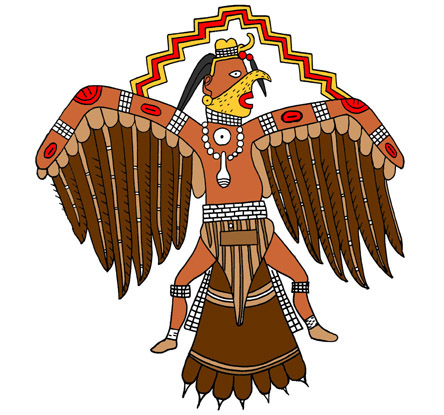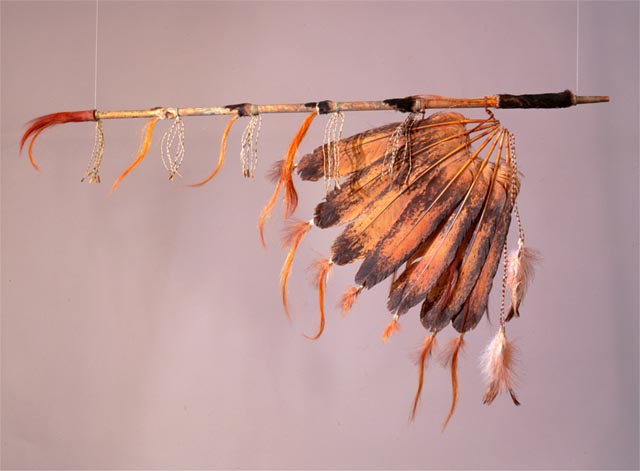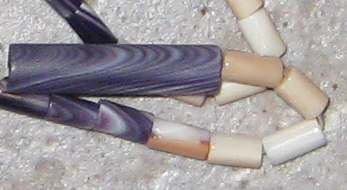|
Red Horn
Red Horn is a culture hero in Siouan oral traditions, specifically of the Ioway and Hocąk (Winnebago) nations. He has different names. Only in Hocąk literature is he known as "Red Horn" (''Hešucka''), but among the Ioway and Hocągara both, he is known by one of his variant names, "He Who Wears (Man) Faces on His Ears". This name derives from the living faces on his earlobes (Hocąk), or earbobs that come to life when he places them on his ears (Ioway). Elsewhere, he is given yet another name, "Red Man" (''Wąkšucka''), because his entire body is red from head to toe. Red Horn was one of the five sons of Earthmaker, whom the Creator fashioned with his own hands and sent to earth to rescue humanity. During his sojourn on earth, he contested both giants and water spirits, and led war parties against the bad spirits who plagued humanity. As Wears Faces on His Ears, he is also said to be a star, although its identity is a subject of controversy. Under the names "One Horn" ('' ... [...More Info...] [...Related Items...] OR: [Wikipedia] [Google] [Baidu] |
History Of Lacrosse
Lacrosse has its origins in a tribal game played by eastern Woodlands Native Americans and by some Plains Indians tribes in what is now the United States of America and Canada. The game was extensively modified by European settlers to create its current collegiate and professional form. There were hundreds of native men playing a ball game with sticks. The game began with the ball being tossed into the air and the two sides rushing to catch it. Because of the large number of players involved, these games generally tended to involve a huge mob of players swarming the ball and slowly moving across the field. Passing the ball was thought of as a trick, and it was seen as cowardly to dodge an opponent. Years later lacrosse is still a popular sport played all over the world. Indigenous North American game Modern day lacrosse descends from and resembles games played by various Native American communities. These include games called ''dehontsigwaehs'' in Oee ("they bump hips"), ''T ... [...More Info...] [...Related Items...] OR: [Wikipedia] [Google] [Baidu] |
Pan-Indian
Pan-Indianism is a philosophical and political approach promoting unity, and to some extent cultural homogenization, among different Indigenous groups in the Americas regardless of tribal distinctions and cultural differences. This approach to political organizing is primarily associated with Native Americans organizing for social justice and cultural revitalization in the Continental United States, but has spread to some other Indigenous communities as well, especially in Canada. Inuit and Métis people may consider themselves part of the broader, pan-Aboriginal community, or some variation thereof. Some academics have also used the term pan-Amerindianism to distinguish from other peoples known as "Indians". Some pan-Indian organizations seek to pool the resources of Indigenous groups in order to protect the interests of Native peoples across the world.Waldman, Carl (2009). "Atlas of The North American Indian" (Third ed.), pp 262, 264, 241. Checkmark Books., New York Early hi ... [...More Info...] [...Related Items...] OR: [Wikipedia] [Google] [Baidu] |
Ceremonial Pipe
A ceremonial pipe is a particular type of smoking pipe, used by a number of cultures of the indigenous peoples of the Americas in their sacred ceremonies. Traditionally they are used to offer prayers in a religious ceremony, to make a ceremonial commitment, or to seal a covenant or treaty. The pipe ceremony may be a component of a larger ceremony, or held as a sacred ceremony in and of itself. Indigenous peoples of the Americas who use ceremonial pipes have names for them in each culture's Indigenous language. Not all cultures have pipe traditions, and there is no single word for all ceremonial pipes across the hundreds of diverse Native American languages. Use in ceremonies Although often called "peace pipes" by Europeans (and, specifically, ''calumet de paix'', by the French), the smoking of a ceremonial pipe to seal a peace treaty is only one use of a ceremonial smoking pipe, by only some of the nations that utilize them. Various types of ceremonial pipes have been used by di ... [...More Info...] [...Related Items...] OR: [Wikipedia] [Google] [Baidu] |
Wampum
Wampum is a traditional shell bead of the Eastern Woodlands tribes of Native Americans. It includes white shell beads hand-fashioned from the North Atlantic channeled whelk shell and white and purple beads made from the quahog or Western North Atlantic hard-shelled clam. In New York, wampum beads have been discovered dating before 1510.Dubin, Lois Sherr. ''North American Indian Jewelry and Adornment: From Prehistory to the Present''. New York: Harry N. Abrams, 1999: 170-171. . Before European contact, strings of wampum were used for storytelling, ceremonial gifts, and recording important treaties and historical events, such as the Two Row Wampum Treaty and the Hiawatha Belt. Wampum was also used by the northeastern Indigenous tribes as a means of exchange, strung together in lengths for convenience. The first colonists understood it as a currency and adopted it as such in trading with them. Eventually, the colonists applied their technologies to more efficiently produce wamp ... [...More Info...] [...Related Items...] OR: [Wikipedia] [Google] [Baidu] |
Long-nosed God Maskette
Long-nosed god maskettes are artifacts made from bone, copper and marine shells (Lightning whelk) associated with the Mississippian culture (800 to 1600 CE) and found in archaeological sites in the Midwestern United States and the Southeastern United States. They are small shield-shaped faces with squared-off foreheads, circular eyes, and large noses of various lengths. They are often shown on Southeastern Ceremonial Complex representations of falcon impersonators as ear ornaments. Long and short nosed versions of the masks have been found in ten different states, with the majority found at sites in Illinois. Many archaeologists now associate them with the Ho-Chunk (Winnebago) stories of the mythological being Red Horn. Archaeology The first long nosed god maskette was found next to a skull in a grave in Big Mound in St. Louis in 1870. Since then over twenty of these artifacts have been discovered in an area encompassing at least ten states. They have also been found in Alabama, A ... [...More Info...] [...Related Items...] OR: [Wikipedia] [Google] [Baidu] |
Mesoamerica
Mesoamerica is a historical region and cultural area in southern North America and most of Central America. It extends from approximately central Mexico through Belize, Guatemala, El Salvador, Honduras, Nicaragua, and northern Costa Rica. Within this region pre-Columbian societies flourished for more than 3,000 years before the Spanish colonization of the Americas. Mesoamerica was the site of two of the most profound historical transformations in world history: primary urban generation, and the formation of New World cultures out of the long encounters among indigenous, European, African and Asian cultures. In the 16th century, Eurasian diseases such as smallpox and measles, which were endemic among the colonists but new to North America, caused the deaths of upwards of 90% of the indigenous people, resulting in great losses to their societies and cultures. Mesoamerica is one of the five areas in the world where ancient civilization arose independently (see cradle of civ ... [...More Info...] [...Related Items...] OR: [Wikipedia] [Google] [Baidu] |
Maya Hero Twins
The Maya Hero Twins are the central figures of a narrative included within the colonial Kʼicheʼ document called Popol Vuh, and constituting the oldest Maya myth to have been preserved in its entirety. Called Hunahpu and Xbalanque in the Kʼicheʼ language, the Twins have also been identified in the art of the Classic Mayas (200–900 AD). The twins are often portrayed as complementary forces. The complementary pairings of life and death, sky and earth, day and night, Sun and Moon, among multiple others have been used to represent the twins. The duality that occurs between male and female is often seen in twin myths, as a male and female twin are conceptualized to be born to represent the two sides of a single entity. The Twin motif recurs in many Native American mythologies; the Maya Twins, in particular, could be considered as mythical ancestors to the Maya ruling lineages. The Hero Twins in word and image After being invited to Xibalba by One-Death and Seven-Death, the L ... [...More Info...] [...Related Items...] OR: [Wikipedia] [Google] [Baidu] |
Algonquian Languages
The Algonquian languages ( or ; also Algonkian) are a subfamily of Indigenous languages of the Americas, indigenous American languages that include most languages in the Algic languages, Algic language family. The name of the Algonquian language family is distinguished from the orthographically similar Algonquin language, Algonquin dialect of the Indigenous Ojibwe language (Chippewa), which is a senior member of the Algonquian language family. The term ''Algonquin'' has been suggested to derive from the Maliseet word (), "they are our relatives/allies". A number of Algonquian languages are considered extinct languages by the modern linguistic definition. Algonquian peoples, Speakers of Algonquian languages stretch from the east coast of North America to the Rocky Mountains. The proto-language from which all of the languages of the family descend, Proto-Algonquian language, Proto-Algonquian, was spoken around 2,500 to 3,000 years ago. There is no scholarly consensus about wh ... [...More Info...] [...Related Items...] OR: [Wikipedia] [Google] [Baidu] |
Two-Spirit
Two-spirit (also two spirit, 2S or, occasionally, twospirited) is a modern, , umbrella term used by some Indigenous North Americans to describe Native people in their communities who fulfill a traditional third-gender (or other gender-variant) ceremonial and social role in their cultures. The term ''Two Spirit'' (original form chosen) was created in 1990 at the Indigenous lesbian and gay international gathering in Winnipeg, and "specifically chosen to distinguish and distance Native American/First Nations people from non-Native peoples". The primary purpose of coining a new term was to encourage the replacement of the outdated and considered offensive, anthropological term, ''berdache''. This new term has not been universally accepted, having been criticized as a term of erasure by traditional communities who already have their own terms for the people being grouped under this new term, and by those who reject what they call the "Western" binary implications, such as implying t ... [...More Info...] [...Related Items...] OR: [Wikipedia] [Google] [Baidu] |
Hummingbirds
Hummingbirds are birds native to the Americas and comprise the biological family Trochilidae. With about 361 species and 113 genera, they occur from Alaska to Tierra del Fuego, but the vast majority of the species are found in the tropics around the equator. They are small birds, with most species measuring in length. The smallest extant hummingbird species is the bee hummingbird, which weighs less than . The largest hummingbird species is the giant hummingbird, weighing . They are specialized for feeding on flower nectar, but all species also consume flying insects or spiders. Hummingbirds split from their sister group, the swifts and treeswifts, around 42 million years ago. The common ancestor of extant hummingbirds is estimated to have lived 22 million years ago in South America. They are known as hummingbirds because of the humming sound created by their beating wings, which flap at high frequencies audible to humans. They hover in mid-air at rapid wing-flapping rates, ... [...More Info...] [...Related Items...] OR: [Wikipedia] [Google] [Baidu] |





.jpg)


